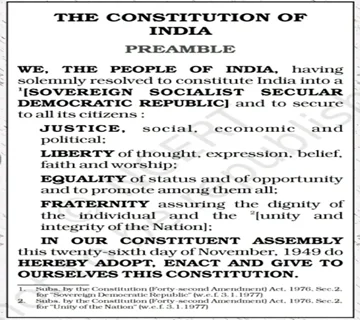Governance
Context: After more than 200 years of colonial rule, India became free at the stroke of midnight on August 15, 1947. The hard-earned independence was an outcome of a long-drawn freedom struggle which was uniting force among the India. Further the Adoption of Constitution of 26 Nov 1949, laid down the vision of founding father of nation for upcoming India and the day of 26 November is celebrated as ‘constitution day.’

About Constitution Day:
- The Constitution of India was adopted by the Constituent Assembly on November 26, 1949 for ‘We the people of India’.
- After being unnoticed for long, only since 2015, the day has begun to be celebrated as Constitution Day. This day is indeed a historic day for the nation, with the framing of a constitution for the governance of independent India.
The historical events that shaped the constitutional framing:
- Inspiration from Tilak Swaraj Bill of 1895:
- Constitution had its inspiration in sources like Tilak’s Swaraj Bill of 1895 (which included rights to free speech, free press, equality before law) and
- The Declaration of Rights of 1918 (where the Indian National Congress demanded that civil and political rights to include the right to life and liberty, freedom of press and association and for all this to be included in the Government of India Act 1919).
- Karachi Session of the Congress in 1931: It is also a significant constitutional development that drew from the Resolution of Fundamental Rights and Economic Changes
- This resolution argues that “in order to end exploitation of the masses, political freedom must include economic freedom”. Along with fundamental rights, it provided for:
- ending of bonded and child labour,
- free primary education,
- expansion of labour welfare,
- regime protection labour unions, women workers,
- providing for redistribution of resources through state control over key industries and national resources,
- recognising the communal problem and laying out protection of minority rights.”
- All these demands would find their way into Part III (Fundamental Rights) and Part IV (Directive Principals of State Policy) of the Constitution.
The vision which conjoins the diverse people of India:
- Richard Kay writes that a people would submit to a constitution, when the constituent assembly crafts a narrative about the creation of the body that is both politically acceptable and historically plausible.
- It’s not only the text, but also the story crafted of the birth of a constitution that is critical in the internalisation of a constitutional order by a people.
- The drafters deployed the considerable political goodwill enjoyed by key national leaders who were members of the assembly to give legitimacy to the Constitution.
- These told a story of how the Constitution reflected the will of the people, and how its egalitarian foundation would create a better, more decent nation.
- Freedom struggle movements and resistance to colonial power was the uniting force that clubbed the people of India from diverse background and it was also good training for constitution-crafting.
Consensus-orientated method while adopting the significant provisions in the constitution:
- Framers of Constitution appreciated the link between consensus in adoption and the legitimacy of the Constitution.
- For instance, when debating the adoption of Hindi as a national language, Rajendra Prasad, president of the Constituent Assembly, said that the choice of national language would have to be “carried out by the whole country”.
- And that even if a majority of the Assembly made a choice that was not approved by a section of the people, then, implementation of the Constitution would be rendered perilous. Hence, Hindi was made “the official language of the Union”, while English was retained to be used for all “official purposes”.
- Yet, while the drafters opted for compromise and consensus in some areas, they made bold choices on others.
- For instance, breaking down traditional privileges like the
- abolition of princely states and royal titles, and
- crafting the country as a democracy based on universal adult franchise, and ending discrimination on grounds of caste, or sex or religion.
Way Forward:
- India’s drafters and the methodologies they adopted to craft their glorious product, hold lessons for contemporary politicians and law makers. Consensus, craft and vision are invaluable while making an instrument to endure.
- As, the Constitution empowers the people as much as the people empower the Constitution.
- It was the foresight, intellect and ingenuity of the great men in the Constituent Assembly that helped succeed in framing a constitution whose acceptability has only grown with each passing generation.
- It is also a time to salute the common citizen of the country who has established an unbreakable bond with the letter and spirit of the Constitution and has at every difficult juncture of our journey renewed her faith and commitment to the lofty ideals of our Constitution.
Therefore, With the completion of 75 years of our independence, we can justifiably take pride in our journey as a nation and our achievements in diverse fields. It is also a time to reaffirm our faith in our people and our Constitution as we enter Amrit Kaal and renew and rededicate our commitment to remain steadfast in achieving our dream of a new self-reliant, strong, united and humane nation in the next 25 years.
Source: Indian Express











